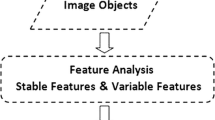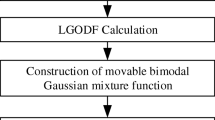Abstract
Building foot prints and building count information in urban areas are very much essential for planning and monitoring developmental activities, efficient natural resource utilization, and provision of civic facilities by governments. Remote sensing data such as satellite/aerial imagery in association with digital elevation model is widely used for automatic extraction of building information. Many researchers have developed different methods for maximizing the detection percentage with minimum errors. A comparative study of different methods available in the literature is presented in this paper by analyzing the primary data sets, derived data sets, and their usage in the automated and semiautomated extraction methods. It is found that the success of the method for automatic building detection in urban areas primarily depends on using combination of high-resolution image data with digital elevation model.
Access this chapter
Tax calculation will be finalised at checkout
Purchases are for personal use only
Similar content being viewed by others
References
Weidner, R.: An approach to Building Extraction From Digital Surface Models. International Archives of Photogrammetry and Remote Sensing, Vol XXXI, Part B3 (1996).
Yuhan, Huang., Li, Zhuo., Haiyan, Tao., Qingli, Shi., Kai, Liu.: A Novel Building Type Classification Scheme Based on Integrated LiDAR and High-Resolution Images. Remote Sensing (2017).
Mahak, Khurana., Vaishali, Wadhwa.: Automatic Building Detection Using Modified Grab Cut Algorithm from High Resolution Satellite Image. International Journal of Advanced Research in Computer and Communication Engineering Vol. 4, Issue 8 (2015).
Benarchid, O., Raissouni, N., El Adib, S., Abbous, A., Azyat, A., Ben Achhab, N., Lahraoua, M., Chahboun, A.: Building Extraction using Object-Based Classification and Shadow Information in Very High Resolution Multispectral Images, a Case Study: Tetuan, Morocco. Canadian Journal on Image Processing and Computer Vision Vol. 4 No. 1 (2013).
Bittnera, K., Cuia, S., Reinartz, P.: Building Extraction from Remote Sensing Data Using Fully Convolution Networks. ISPRS Workshop, Hannover (2017).
City Cluster Development: Triggering Inclusive Economic Growth. ADB Urban Innovations Internet Resource. https://www.adb.org/sites/default/files/publication/27883 (2018).
Density Based Satial Clustering- Identifying industrial clusters in the UK: Methodology Report by Department for Business, Energy and Industrial Strategy. https://www.gov.uk/ (2017).
Philipp, Geyer., Arno, Schlueter.: Performance-Based Clustering for Building Stock Management at Regional Level. Internet resource. https://lirias.kuleuven.be/handle/123456789/562944 (2016).
David, Hsu.: Comparison of integrated clustering methods for accurate and stable prediction of building energy consumption data. Applied Energy 160, 153–16 (2015).
Suhaibah, Azri., Alias, Abdul Rahman., Uznir, Ujang., François, Anton., Darka, Mioc.: 3D City Models. Encyclopedia of GIS, Editors: Shashi Shekhar, Hui Xiong, Xun Zhou, Internet resource, https://doi.org/10.1007/978-3-319-17885-1_100002 (2017).
Liqiang, Zhang., Chen, Dong.: A spatial cognition-based urban building clustering approach and its applications. International Journal of Geographical Information Science (2012).
Poonam, S. Tiwari., Hina, Pande., Badri Narayan, Nanda.: Building Footprint Extraction from IKONOS imagery based on multi-scale object oriented fuzzy classification for urban disaster management. Symposium of ISPRS Commission IV, Goa (2006).
Karuna, Sitaram Kirwale., Seema, S Kawathekar.: Feature Extraction of Build-up area using Morphological Image Processing. International Journal of Emerging Trends & Technology in Computer Science (IJETTCS), Vol. 4, Issue 5(1) (2015).
Tian, J., Krau, T., d’Angelo, P: Automatic Rooftop Extraction in Stereo Imagery Using Distance and Building Shape Regularised Level Set Evolution. ISPRS Workshop, Hannover (2017).
Txomin, Hermosilla., Luis, A Ruiz., Jorge A Recio., Javier, Estornell.: Evaluation of Automatic Building Detection Approaches Combining High Resolution Images and LiDAR Data. Remote Sensing (2011).
Sefercik, U G., Karakis, S., Atalay, C., Yigit, I., Gokmen, U.: Novel fusion approach on automatic object extraction from spatial data: case study Worldview-2 and TOPO5000. Geocarto International (2017).
Yiming, Yan., Zhichao, Tan., Nan, Su., and Chunhui, Zhao.: Building Extraction Based on an Optimized Stacked Sparse Auto encoder of Structure and Training Samples Using LIDAR DSM and Optical Images. Sensors (2017).
Demir, N, Poli, D, Baltsavias, E.: Extraction of Buildings and Trees Using Image and LiDAR data”, The International Archives of the Photogrammetry, Remote Sensing and Spatial Information Sciences. Vol. XXXVII. Part B4. Beijing (2008).
Feifei, Peng., Jianya, Gong., Le, Wang., Huayi, Wu., Pengcheng, Liu.: A New Stereo Pair Disparity Index (SPDI) for Detecting Built-Up Areas from High-Resolution Stereo Imagery. Remote Sensing (2017).
Jiang, N., Zhang, J X., Li, H T., Lin, X G.: Semi-Automatic Building Extraction from High Resolution Imagery Based on Segmentation. International Workshop on Earth Observation and Remote Sensing Applications, Beijing (2008).
Gregoris, Liasis., Stavros, Stavrou.: Building Extraction in Satellite Images using Active Contours and Colour Feature. International Journal of Remote Sensing, 37:5, 1127–1153 (2016).
Parivallal, R., Nagarajan, B., Nirmala, Devi.: Object Identification Method using Maximum Likelihood Algorithm from Google Map. International Journal of Research in computer applications and Robotics, Vol. 2 Issue. 2, Pg.: 153–159 (2014).
Pascal, Kaiser., Jan, Dirk Wegner., Aur´elien, Lucchi., Martin, Jaggi., Thomas, Hofmann., Konrad Schindler.: Learning Aerial Image Segmentation from Online Maps. IEEE Transactions on Geoscience and Remote Sensing, Vol. 55, Issue: 11 (2017).
Małgorzata, Verőné Wojtaszek.: Opportunities of object-based image analysis for detecting urban environment. presentation at IGIT, Internet resource, www.geo.info.hu (2015).
McGlone, J.C., Shufelt, J.A.: Projective and Object Space Geometry for Monocular Building Extraction. Proceedings of Computer Vision and Pattern Recognition, 21–23; pp. 54–61 (1994).
Jeffery, A. shufflet.: Exploiting Photogrammetric Methods for Building Extraction in Aerial Images. The International Archives of the Photogrammetry and Remote Sensing Vol. XXXI, Part B6, Voenna (1996).
Ibrahim, F. Shaker., Amr, Abd-Elrahman., Ahmed, K. Abdel-Gawad., Mohamed, A. Sherief.: Building Extraction from High Resolution Space Images in High Density Residential Areas in the Great Cairo Region. Remote Sensing (2011).
Huan, Ni., Xiangguo, Lin., Jixian, Zhang.: Classification of ALS Point Cloud with Improved Point Cloud Segmentation and Random Forests. Remote Sensing (2017).
Jenifer, Grace Giftlin. C., Jenicka, S.: A Survey Paper on Buildings Extraction from Remotely Sensed Images. International Conference on Intelligent Computing Techniques (ICICT), Tirunelveli (2017).
Mathieu, Brédif., Olivier, Tournaire., Bruno, Vallet., Nicolas, Champion.: Extracting polygonal building footprints from digital surface models: A fully-automatic global optimization framework. ISPRS Journal of Photogrammetry and Remote Sensing, 77, pp. 57–65 (2013).
Author information
Authors and Affiliations
Corresponding author
Editor information
Editors and Affiliations
Rights and permissions
Copyright information
© 2019 Springer Nature Singapore Pte Ltd.
About this paper
Cite this paper
Pendyala, V.S.S.N.G.K., Kalluri, H.K., Venkataraman, V.R., Rao, C.V. (2019). Comparative Study of Automatic Urban Building Extraction Methods from Remote Sensing Data. In: Bapi, R., Rao, K., Prasad, M. (eds) First International Conference on Artificial Intelligence and Cognitive Computing . Advances in Intelligent Systems and Computing, vol 815. Springer, Singapore. https://doi.org/10.1007/978-981-13-1580-0_58
Download citation
DOI: https://doi.org/10.1007/978-981-13-1580-0_58
Published:
Publisher Name: Springer, Singapore
Print ISBN: 978-981-13-1579-4
Online ISBN: 978-981-13-1580-0
eBook Packages: Intelligent Technologies and RoboticsIntelligent Technologies and Robotics (R0)




